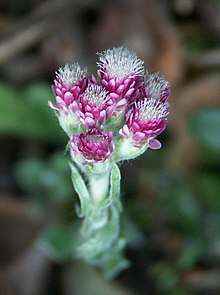Antennaria dioica
Antennaria dioica (mountain everlasting,[2] stoloniferous pussytoes,[3] catsfoot or cudweed) is a Eurasian and North American species of flowering plants in the family Asteraceae. It is found in cool northern and mountainous regions of Europe and northern Asia (Russia, Mongolia, Japan, Kazakhstan, China (Xinjiang, Heilongjiang, Gansu)), and also in North America in Alaska only.[4][5][6]
| Antennaria dioica | |
|---|---|
 | |
| Scientific classification | |
| Kingdom: | Plantae |
| Clade: | Tracheophytes |
| Clade: | Angiosperms |
| Clade: | Eudicots |
| Clade: | Asterids |
| Order: | Asterales |
| Family: | Asteraceae |
| Genus: | Antennaria |
| Species: | A. dioica |
| Binomial name | |
| Antennaria dioica | |
| Synonyms[1] | |
|
Synonymy
| |
Description
Antennaria dioica is a herbaceous perennial plant growing to 10–20 cm tall, with a rosette of basal spoon-shaped leaves 4 cm long, and 1 cm broad at their broadest near the apex; and smaller leaves arranged spirally up the flowering stems. The flowers are produced in capitula (flowerheads) 6–12 mm diameter with pale pink ray florets and darker pink disc florets.
It is dioecious, but can also reproduce without fertilisation. It is found in groups which can be all-female colonies, all-male colonies, and also mixed colonies. The male plants have whiter flower heads than female plants.
Uses
While not widely used in herbal medicine, the plant was believed to have antitussive, astringent, diuretic and emollient properties.[7] It has been traditionally used to treat bronchitis, liver and gall bladder complaints, hepatitis and diarrhea.[7] Externally, it has been used as a gargle for treating tonsillitis and as a douche for vaginitis.[7]
John Gerard's Herball (1597) describes the plant: "When the flower hath long flourished and is waxen old, then comes there in the middest of the floure a certain brown yellow thrumme, such as is in the middest of the daisie, which floure being gathered when it is young may be kept in such manner (I meane in such freshness and well-liking) by the space of a whole year after in your chest or elsewhere, wherefore our English women have called it 'Live Long,' or 'Live-for ever,' which name doth aptly answer this effects."[8]
References
- The Plant List, Antennaria dioica (L.) Gaertn.
- "BSBI List 2007". Botanical Society of Britain and Ireland. Archived from the original (xls) on 2015-01-25. Retrieved 2014-10-17.
- "Antennaria dioica". Natural Resources Conservation Service PLANTS Database. USDA. Retrieved 18 March 2016.
- Flora of China Vol. 20-21 Page 789 蝶须 die xu Antennaria dioica (Linnaeus) Gaertner, Fruct. Sem. Pl. 2: 410. 1791.
- Flora of North America Vol. 19, 20 and 21 Page 406 Stoloniferous pussytoes Antennaria dioica (Linnaeus) Gaertner, Fruct. Sem. Pl. 2: 410. 1791.
- Altervista Flora Italiana, Sempiterni di montagna, Antennaria dioica (L.) Gaertn. includes photos and European distribution map
- "Antennaria dioica Catsfoot, Stoloniferous pussytoes PFAF Plant Database". pfaf.org. Retrieved 2019-04-03.
- Grieve, Maud (1971). A Modern Herbal: The Medicinal, Culinary, Cosmetic and Economic Properties, Cultivation and Folk-lore of Herbs, Grasses, Fungi, Shrubs, & Trees with All Their Modern Scientific Uses, Volume 1. p. 175.
- Flora Europaea: Antennaria dioica distribution in Europe
- Germplasm Resources Information Network: Antennaria dioica
